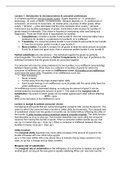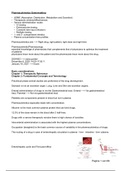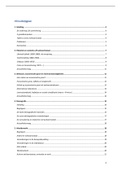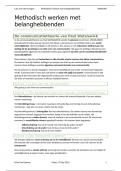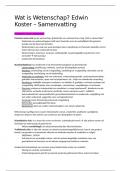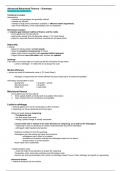Week 1: The Science of Measuring Health and Disease
Learning Objectives
Critical evaluation of key aspects of Epidemiological approach, concepts and definitions
Application of basic biostatistical methods in Epidemiology
Interpretation of Epidemiological Evidence
Contents
Key Principles of Epidemiology ..................................................................................................... 1
Objectives and Functions ............................................................................................................ 2
The Role of Epidemiology in Public Health ............................................................................... 3
Descriptive epidemiology ........................................................................................................... 6
Analytic Epidemiology ............................................................................................................... 7
Branches of Epidemiology .......................................................................................................... 8
Basic biostatistics in Epidemiology ................................................................................................ 8
Descriptive statistics ................................................................................................................... 9
Measures of Central Tendency ................................................................................................. 10
Measures of Dispersion............................................................................................................. 12
Frequency Distribution ............................................................................................................. 14
The relationship between the normal distribution, standard deviation, and standard scores .... 16
Statistical Inference ................................................................................................................... 18
Comparing samples: the t-test ................................................................................................... 19
Interpreting Epidemiological Evidence ........................................................................................ 21
Type I and type II errors ........................................................................................................... 22
Standard Error and Confidence Intervals .................................................................................. 22
,Introduction
Epidemiology is considered one of the fundamental sciences of Public Health. Albeit it being a
relatively young discipline accounting for a brief history from the 19 th century, the discoveries and
advancements in medicine that came with its development and establishment as the backbone of
Public Health, cannot be overemphasized.
Key Principles of Epidemiology
The definition of Epidemiology has changed during the 20 th century reflecting the transformation
from its key focus (i.e. investigation of outbreaks of communicable diseases) to a modern
multidimensional, yet concise, definition portraying its principle features. According to Spasoff
and Harris (2001) epidemiology is concerned with ‘the study of the distribution and
determinants of health-related states and events in specified populations, and the application
of this study to the control of health problems’. By depicting the key words in this definition we
will understand the main principles of Epidemiology:
Study Relates to surveillance, observation, hypothesis testing, analytic research, and experiments
Distribution Directs to analysis by time, place, and classes of persons affected
Determinants Includes all physical, biological, social, cultural, and behavioral factors that affect health
Health-related states Refers to illnesses, causes of death, behaviors (i.e. alcohol consumption, exercise), reactions to
and events preventive programs, and provision and utilization of healthcare services
Specified populations Implies to those with identifiable characteristics such as occupation, ethnicity/race
Application to control Refers to the aim of epidemiology to promote, protect, and restore health
Figure 1: Key principles of Epidemiology in accordance with Last, Spasoff and Harris (2001)
1
, From the above definition and its interpretation, we can conclude that Epidemiologists are dealing
with a range of health-related states and events. Along with diseases, disabilities and deaths, they
are looking at behaviours related to health and wellbeing, environmental health, genetic markers
of disease risks. An equally important aspect of modern epidemiology is its focus on the
improvement of health and the prevention of disease.
Objectives and Functions
According to Schoenbach and Rosamond (2000) adaptation of the work of the well-recognized
Public Health physician and epidemiologist Terris Milton the main function of modern
epidemiology revolves around the following seven factors:
1. Investigating the agent, host, and environmental factors impacting health with the purpose
of offering well-grounded foundations for the development of preventative measures and
the promotion of health.
2. Determining the relative importance of causes of illness, disability, and death, in order to
establish priorities for research and action.
3. Identifying populations under risk from particular causes of disease so the specific
interventions are targeted accordingly.
4. Evaluating existing and newly developed preventive and clinical programs and measures
for improving the health of the population.
5. Studying the natural history, aetiology and prognosis of the disease.
6. Conducting surveillance of disease and injury occurrence in populations and of the levels
of risk factors.
7. Investigating outbreaks to identify their source and controlling epidemics (i.e. Sars-Cov-2,
Ebola Virus Disease, Malaria, Cholera etc.).
2
Learning Objectives
Critical evaluation of key aspects of Epidemiological approach, concepts and definitions
Application of basic biostatistical methods in Epidemiology
Interpretation of Epidemiological Evidence
Contents
Key Principles of Epidemiology ..................................................................................................... 1
Objectives and Functions ............................................................................................................ 2
The Role of Epidemiology in Public Health ............................................................................... 3
Descriptive epidemiology ........................................................................................................... 6
Analytic Epidemiology ............................................................................................................... 7
Branches of Epidemiology .......................................................................................................... 8
Basic biostatistics in Epidemiology ................................................................................................ 8
Descriptive statistics ................................................................................................................... 9
Measures of Central Tendency ................................................................................................. 10
Measures of Dispersion............................................................................................................. 12
Frequency Distribution ............................................................................................................. 14
The relationship between the normal distribution, standard deviation, and standard scores .... 16
Statistical Inference ................................................................................................................... 18
Comparing samples: the t-test ................................................................................................... 19
Interpreting Epidemiological Evidence ........................................................................................ 21
Type I and type II errors ........................................................................................................... 22
Standard Error and Confidence Intervals .................................................................................. 22
,Introduction
Epidemiology is considered one of the fundamental sciences of Public Health. Albeit it being a
relatively young discipline accounting for a brief history from the 19 th century, the discoveries and
advancements in medicine that came with its development and establishment as the backbone of
Public Health, cannot be overemphasized.
Key Principles of Epidemiology
The definition of Epidemiology has changed during the 20 th century reflecting the transformation
from its key focus (i.e. investigation of outbreaks of communicable diseases) to a modern
multidimensional, yet concise, definition portraying its principle features. According to Spasoff
and Harris (2001) epidemiology is concerned with ‘the study of the distribution and
determinants of health-related states and events in specified populations, and the application
of this study to the control of health problems’. By depicting the key words in this definition we
will understand the main principles of Epidemiology:
Study Relates to surveillance, observation, hypothesis testing, analytic research, and experiments
Distribution Directs to analysis by time, place, and classes of persons affected
Determinants Includes all physical, biological, social, cultural, and behavioral factors that affect health
Health-related states Refers to illnesses, causes of death, behaviors (i.e. alcohol consumption, exercise), reactions to
and events preventive programs, and provision and utilization of healthcare services
Specified populations Implies to those with identifiable characteristics such as occupation, ethnicity/race
Application to control Refers to the aim of epidemiology to promote, protect, and restore health
Figure 1: Key principles of Epidemiology in accordance with Last, Spasoff and Harris (2001)
1
, From the above definition and its interpretation, we can conclude that Epidemiologists are dealing
with a range of health-related states and events. Along with diseases, disabilities and deaths, they
are looking at behaviours related to health and wellbeing, environmental health, genetic markers
of disease risks. An equally important aspect of modern epidemiology is its focus on the
improvement of health and the prevention of disease.
Objectives and Functions
According to Schoenbach and Rosamond (2000) adaptation of the work of the well-recognized
Public Health physician and epidemiologist Terris Milton the main function of modern
epidemiology revolves around the following seven factors:
1. Investigating the agent, host, and environmental factors impacting health with the purpose
of offering well-grounded foundations for the development of preventative measures and
the promotion of health.
2. Determining the relative importance of causes of illness, disability, and death, in order to
establish priorities for research and action.
3. Identifying populations under risk from particular causes of disease so the specific
interventions are targeted accordingly.
4. Evaluating existing and newly developed preventive and clinical programs and measures
for improving the health of the population.
5. Studying the natural history, aetiology and prognosis of the disease.
6. Conducting surveillance of disease and injury occurrence in populations and of the levels
of risk factors.
7. Investigating outbreaks to identify their source and controlling epidemics (i.e. Sars-Cov-2,
Ebola Virus Disease, Malaria, Cholera etc.).
2



